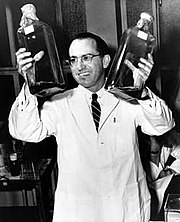
A vaccine is a biological preparation that provides active acquired immunity to a particular disease. A vaccine typically contains an agent that resembles a disease-causing micro-organism and is often made from weakened or killed forms of the microbe, its toxins are one of its surface proteins. The agent stimulates the body's immune system to recognize the agent as a threat, destroy it, and keep a record of it, so that the immune system can more easily recognize and destroy any of these micro-organisms that it later encounters. Vaccines can be prophylactic (example: to prevent or ameliorate the effects of a future infection by any natural or "wild" pathogen), or therapeutic (e.g., vaccines against cancer are also being investigated).
The administration of vaccines is called vaccination. The effectiveness of vaccination has been widely studied and verified; for example, the influenza vaccine,[1] the HPV vaccine,[2] and the chicken pox vaccine.[3] Vaccination is the most effective method of preventing infectious diseases;[4] widespread immunity due to vaccination is largely responsible for the worldwide eradication of smallpox and the restriction of diseases such as polio, measles, and tetanus from much of the world. The World Health Organization (WHO) reports that licensed vaccines are currently available to prevent or contribute to the prevention and control of twenty-five infections.[5]
The terms vaccine and vaccination are derived from Variolae vaccinae (smallpox of the cow), the term devised by Edward Jenner to denote cowpox. He used it in 1798 in the long title of his Inquiry into the...Variolae vaccinae...known...[as]...the Cow Pox, in which he described the protective effect of cowpox against smallpox.[6] In 1881, to honour Jenner, Louis Pasteur proposed that the terms should be extended to cover the new protective inoculations then being developed.[7]
Category:Vaccination Category:Virology
- ^ Fiore AE, Bridges CB, Cox NJ (2009). "Seasonal influenza vaccines". Curr. Top. Microbiol. Immunol. Current Topics in Microbiology and Immunology. 333: 43–82. doi:10.1007/978-3-540-92165-3_3. ISBN 978-3-540-92164-6. PMID 19768400.
{{cite journal}}: CS1 maint: multiple names: authors list (link) - ^ Chang Y, Brewer NT, Rinas AC, Schmitt K, Smith JS (July 2009). "Evaluating the impact of human papillomavirus vaccines". Vaccine. 27 (32): 4355–62. doi:10.1016/j.vaccine.2009.03.008. PMID 19515467.
{{cite journal}}: CS1 maint: multiple names: authors list (link) - ^ Liesegang TJ (August 2009). "Varicella zoster virus vaccines: effective, but concerns linger". Can. J. Ophthalmol. 44 (4): 379–84. doi:10.3129/i09-126. PMID 19606157.
- ^
- United States Centers for Disease Control and Prevention (2011). A CDC framework for preventing infectious diseases. Accessed 11 September 2012. "Vaccines are our most effective and cost-saving tools for disease prevention, preventing untold suffering and saving tens of thousands of lives and billions of dollars in healthcare costs each year."
- American Medical Association (2000). Vaccines and infectious diseases: putting risk into perspective. Accessed 11 September 2012. "Vaccines are the most effective public health tool ever created."
- Public Health Agency of Canada. Vaccine-preventable diseases. Accessed 11 September 2012. "Vaccines still provide the most effective, longest-lasting method of preventing infectious diseases in all age groups."
- United States National Institute of Allergy and Infectious Diseases (NIAID). NIAID Biodefense Research Agenda for Category B and C Priority Pathogens. Accessed 11 September 2012. "Vaccines are the most effective method of protecting the public against infectious diseases."
- ^ World Health Organization, Global Vaccine Action Plan 2011-2020. Geneva, 2012.
- ^ Baxby, Derrick (1999). "Edward Jenner's Inquiry; a bicentenary analysis". Vaccine. 17 (4): 301–7. doi:10.1016/s0264-410x(98)00207-2. PMID 9987167.
- ^ Pasteur, Louis (1881). "Address on the Germ Theory". Lancet. 118 (3024): 271–2. doi:10.1016/s0140-6736(02)35739-8.